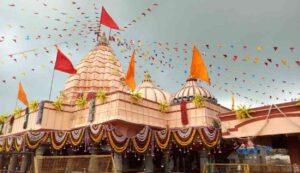Chintaman Ganesh Temple: On the auspicious occasion of Ganesh Chaturthi, know the history of this miraculous Ganesh temple of Ujjain
Chintaman Ganesh Temple: For centuries, Ujjain, an ancient city in the Indian state of Madhya Pradesh, has been an important center of religious and spiritual activity. The Chintaman Ganesh Temple is an important pilgrimage center dedicated to Lord Ganesha, who is worshipped as the god of wisdom, prosperity and destroyer of obstacles, among the countless temples located in this sacred place.

One of the most ancient and famous temples dedicated to Lord Ganesha, the god of wisdom and destroyer of obstacles, is the Chintaman Ganesh Temple located in Ujjain, Madhya Pradesh. Devotees say that visiting this holy temple relieves worries and brings peace and prosperity, making it extremely spiritually significant.
An idol of Lord Ganesha, known as Chintaman, the remover of all suffering, is located in the center of the sanctum sanctorum. This idol is believed to be self-manifested, emitting a strong, ancient aura. Devotion to Lord Ganesha here is focused on him, along with his wives, Riddhi and Siddhi, as the ultimate destroyer of problems and obstacles.
History of Chintaman Ganesh Temple
This temple has deep roots in Ujjain’s rich spiritual and cultural heritage and is believed to be several centuries old. The idol of Lord Ganesha installed in the temple is said to be Swayambhu, which means it is naturally formed from the earth. Combining the Sanskrit words chinta (worry) and mani (gem), the name of the temple “Chintaman” symbolizes Lord Ganesha’s ability to remove troubles and bestow bliss to his followers.
Religious significance: A place where troubled minds can find refuge
In Hinduism, Lord Ganesha enshrined in these temples is considered the creator of rituals and the remover of worries. Especially on Ganesh Chaturthi, devotees visit the temple in the hope of receiving heavenly blessings that will enable them to overcome their sufferings and lead a prosperous life in the future.
Historical Basis: An Inscribed Legacy
The Chintaman Ganesh Temple dating back to the Paramara period is a monument of architectural grandeur of the eleventh and twelfth centuries. According to local folklore, Sita herself is believed to have founded this temple, whose history can be traced back to the Ramayana period.
Architectural Grandeur: An Exploration of the Past
The Paramaras who ruled Malwa at the time had a significant influence on the architecture of the Chintaman Ganesh Temple, which is an excellent example of eleventh and twelfth century craftsmanship. Finely carved stone sculptures and pillars adorn the exterior and interior of the temple, reminiscent of the ancient art of the time.
Additionally, the temple has a fort-like wall on its exterior, which is a hallmark of the Maratha style. This suggests that the temple was rebuilt during the Maratha period. The epitome of Hindu temple architecture is the domed shikhara located in the sanctum sanctorum and the mandapa. The magnificence of the temple is further enhanced by the famous and exquisitely carved pillars of the mandapa.
The temple is located in a complex that is protected by a fortified wall and an entrance gate, and also has a granite shikhara on its domed roof. The historical significance of the temple as a fortified structure and a place of worship is highlighted by this blend of its defensive features and religious aspects.
Apart from being a place of worship, the Chintaman Ganesh Temple is a veritable gold mine of architectural and historical marvels, inviting both history buffs and believers to explore its rich artistic and religious heritage.
Myths associated with Chintaman Ganesh Temple
There are many legends prevalent about the Chintaman Ganesh Temple, which further add to its supernatural charm. One of the major myths is that the idol of Lord Ganesha in the temple is Swayambhu, which indicates that it was created not by human hands, but through divine intervention. Since it symbolizes a divine presence that has existed since time immemorial, this form of the Lord is highly respected.
According to another belief, this temple was built by Lord Rama’s wife Sita during her exile. It is said that to protect herself and get rid of all difficulties, she installed the idol of Lord Ganesha here.
Additionally, it is also said that Lord Ganesha, the deity of the temple, vowed to appear in the form of a lotus in a river flowing to the west of the temple after appearing in the dream of King Vikramaditya. It is said that this incident led to the idol being installed where it is today.
Chintaman Ganesh Temple is an important spiritual site because of these stories, which make the history of the temple even richer and highlight the unwavering faith and devotion of the devotees towards Lord Ganesha.
Chintaman Ganesh Temple Opening Timings
The Chintaman Ganesh Temple in Ujjain warmly welcomes devotees for some time. The following are the opening timings of the temple:
Opening Timings: The temple is open from 6:00 AM to 12:00 PM.
Evening Timings: The temple reopens at 5:00 PM and remains open till 10:00 PM.
Rituals at Chintaman Ganesh Temple
Spirituality
A hub of religious activities, the Chintaman Ganesh Temple hosts a number of ceremonies that highlight the fundamental traditions and values of Hinduism.
Following are some of the main customs
Daily Puja: Devotees worship Lord Ganesha in the temple’s daily puja and seek his blessings.
Ganesh Chaturthi Celebration: During the celebration of Ganesh Chaturthi, the temple becomes a hub of joy. Devotees adorn the idol of Lord Ganesha with garlands and flowers and offer special prayers. One of the important occasions that take place in this sacred complex is the celebration of the birth anniversary of Lord Ganesha.
Wednesday Fairs: Fairs are held at the temple every Wednesday during the month of Chaitra, which usually falls between March and April.
Marriage Rituals: Families in the Ujjain region have a tradition of performing marriage rituals at the Chintaman Ganesh Temple and seeking blessings from Lord Ganesha for a happy and trouble-free married life.
These rituals, apart from being religious rituals, are also a way for the community to come together and celebrate their religion and cultural history.
How can I reach the temple
For those who want to visit, this temple is located about 7 km southwest of Ujjain city, on the Fatehabad railway line, across the Kshipra river. Visiting the Chintaman Ganesh temple in Ujjain will give you a spiritually rich experience. You can plan your trip as follows:
Best time to visit the temple
Winter, which runs from October to March, is the most ideal time of the year to visit this historic temple.
Reaching the temple
Air: The nearest airport is the Devi Ahilya Bai Holkar Airport in Indore, about 55 km from Ujjain. From there you can take a bus or taxi to Ujjain.
Rail: Good rail service is available to Ujjain. This temple is located about 7 km southwest of Ujjain city, on the Fatehabad railway line, across the Kshipra river.
By Road: Ujjain has an excellent road system that connects it to other cities. You can take a bus or car to Ujjain and then use local transport to the temple.

